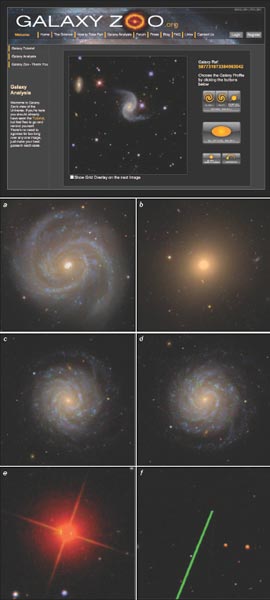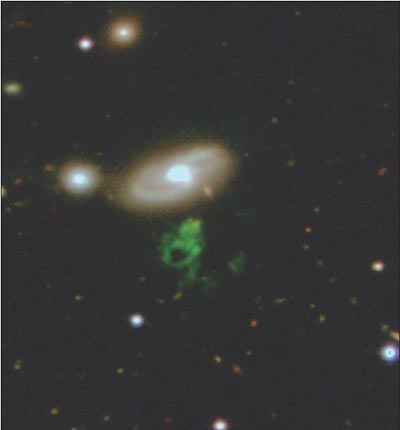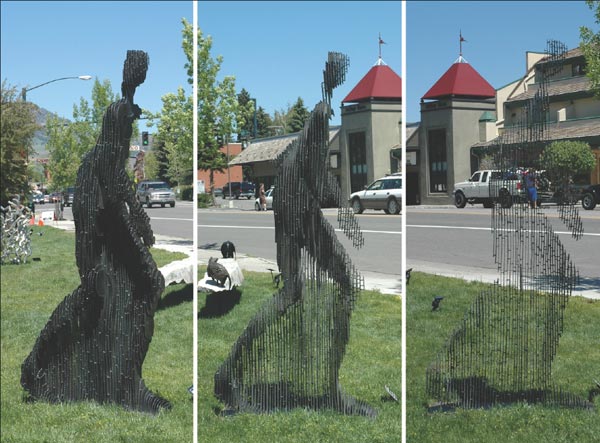Modern astrophysics is a world dominated by large observatories, whether it is the Very Large Telescope in the Atacama desert in Chile or the Hubble Space Telescope orbiting high above the Earth. Access to these facilities is granted only as a result of fierce competition between astronomers, each of whom will have spent years gaining a first degree and a PhD just to be in the game. In the rarefied world of modern research, it may come as a surprise that our project, Galaxy Zoo, is producing science from the work of hundreds of thousands of Web users.
Public participation in science is nothing new, of course. Despite the impressive array of telescopes now strung across the globe, expert amateur astronomers have continued to make contributions over the years: discovering comets, asteroids and, most recently and most remarkably, extrasolar planets. Monitoring the swirling clouds of Jupiter or the changing brightness of variable stars is a job for amateurs too, as they do not have to bid for observing time in order to do the work. They carry out their research with as much dedication as any professional, putting in long hours at the eyepiece and travelling to better observing sites in their free time in the hope of catching special astronomical events.
In the late 1990s a different kind of amateur astronomy emerged that did not require clear skies and a telescope, but rather just an Internet connection. SETI@home, launched in 1999, was the first of a generation of programs that made use of the idle time of users’ computers by taking over the screensavers of millions of eager ET seekers. The program analysed data obtained using the giant Arecibo radio telescope in Puerto Rico, combing through the frequencies for signals that might suggest intelligence. No aliens called, but the idea germinated, and a variety of similar projects followed — such as Folding@home (protein folding) or ClimatePrediction.net (modelling global warming), to name but two.
While these projects have been popular, taking part in them was essentially a passive process. A second set of projects, pioneered by Stardust@Home, required a little more initiative and time on your hands. The idea behind the Stardust@Home project was to get volunteers to sort through images from samples collected by the Stardust spacecraft and identify minuscule interstellar dust grains impacts. Another such project with a similar format, ClickWorkers, required the public to classify craters and other features drawn from an archive of images from NASA’s Mars missions. The common ground between these projects is that they make use of the human brain as a powerful pattern-recognition tool, and one that — despite the advances in automated systems — can still outperform a computer.
Galaxy Zoo is the latest, and now the largest, of such enterprises. The launch of the initiative was announced just over a year ago, with a brief news story on BBC Radio 4’s Today programme. Listeners to Today, and those who followed them, were asked to go online in their spare time and help catalogue nearly a million galaxies according to their shape and, if possible, the direction of their rotation — tasks that are much simpler for a human to do than using computerized pattern recognition. As of July this year, almost 150,000 amateur cyber-astronomers had submitted more than 50 million classifications, enabling us to carry out scientific research that would have otherwise been impossible. As a result, we have submitted four scientific papers for publication so far, with the first two already accepted by Monthly Notices of the Royal Astronomy (MNRAS). With many more results on the way, there are already telescopes lined up for follow-up studies, including Hubble itself, and a second version of the website is undergoing testing. The project has been an unprecedented success.
A different kind of zoo
Galaxy Zoo grew out of the work carried out at the University of Oxford in the UK by one of us (CJL) with Kevin Schawinski, now a postdoctoral researcher at Yale University in the US. Schawinski, while working for a DPhil, studied the remarkable properties of a set of elliptical galaxies discovered by sorting through 50,000 galaxy images provided by the robotic Sloan Digital Sky Survey (SDSS) telescope in New Mexico. In the past, most astronomers selected elliptical galaxies from the SDSS by using a variety of proxies for shape, with criteria such as colour, density profile or spectral features being most common. However, Schawinski found that these methods excluded a small fraction of important elliptical galaxies that were undergoing star formation.
Schawinski’s discovery challenged the traditional picture of elliptical galaxies as being “old, red and dead”. Sites of recent star formation in any galaxy are marked by the presence of young, massive blue stars — think of the arms of a spiral galaxy like the Milky Way. The absence of these blue stars in elliptical galaxies tells us that most, if not all, of these galaxies are long past their peak of star formation. By looking at the fraction that break this rule, Schawinski and CJL hoped to shed light on the processes that govern the formation of all elliptical galaxies.
It became clear, though, that the work we wanted to do would need more than the sample of galaxies that we had to hand. In particular, Schawinski had focused on one slice of the universe. A more local sample was necessary to provide targets for telescopes that might see the molecular gas associated with star formation. That meant going back to the original images and classifying more galaxies.
At about the same time, one of us (KL) and an another Oxford cosmologist, Anze Slosar, were considering results published by Michael Longo of the University of Michigan in the US. Longo had looked at a few thousand spiral galaxies and claimed that there was a preferred handedness to the rotation of the spiral galaxies in the SDSS. The galaxies apparently tended to rotate around a common axis that happened to align with the same direction as the “axis of evil” anomaly — an intriguing non-random pattern of hot and cold spots in the cosmic microwave background — that KL had discovered in 2006. This result was rather hard to swallow as it implied an unexpected preferred direction in the local universe. KL and Slosar were thus keen to follow this up with further analysis, which would involve collecting the observed rotation direction of tens of thousands of spiral galaxies.
Not much brainstorming was necessary to realize that the two problems could be solved by the same solution: build a website to put the SDSS sample online and invite the public to examine the images. A core team was quickly recruited, including Bob Nichol, Daniel Thomas and (later) Steven Bamford, all from the University of Portsmouth in the UK. Nichol was one of the team who helped create the SDSS, and he brought with him Alex Szalay from Johns Hopkins University in the US and the resources of its computing department, which were to prove critical. With no budget, the site was built by pressganged volunteers Phil Murray of Fingerprint Digital Media in Belfast and Dan Andreescu, now of Linklab in New York. On launch day, 12 July 2007, we were joined by outreach expert Jordan Raddick, also of Johns Hopkins. As well as building and releasing an online project, the team also had to get used to working remotely — not only have the entire team yet to gather in a single place, but to the best of our knowledge there is no one person who has met us all.
The site was kept very simple, in the hope of gaining as much data from as many people as possible. The galaxies are separated using the SDSS’s robotic software and then, for each image, a volunteer is asked if the galaxy is a spiral or an elliptical. If it is a spiral galaxy, then the volunteers are asked if they can discern the direction of the spiral arms. There are also the options of “star/don’t know” and merger. The fundamental scientific goal was to obtain a large catalogue of galaxies categorized by simple morphology, i.e. elliptical or spiral. The project also sought to check Longo’s results and to obtain a catalogue of galactic rotation directions that would probe possible correlations between the angular momentum of neighbouring galaxies, as predicted by some theories of structure formation.
Voorwerpen and preferred directions
Once launched, the Galaxy Zoo website quickly attracted an avalanche of attention from the public and media alike. A story about it on the BBC News website quickly became one of the most e-mailed stories of that day and the initial traffic was such that it temporarily brought the Galaxy Zoo server down in the most catastrophic manner imaginable. Thanks to the hard work of the technical team, we were quickly back online and gaining traffic of over 70,000 classifications an hour. This meant that the million hits that the team initially hoped for were achieved in a matter of days. By the end of November 2007 every galaxy in the sample had been observed by on average 40 people; a signal-to-noise ratio that the team had only dreamed of achieving.
With multiple independent classifications for the morphology of each galaxy, we thus obtained a statistical error for each one — a unique advantage for this kind of project. For about a third of the roughly 900,000 galaxies online, more than 80% of people agreed on the morphology. From that part of the sample, about 63% of galaxies were found to be ellipticals and 34% spiral. Comparisons with limited samples classified by experts have shown the results to be in excellent agreement, although the catalogue of Galaxy Zoo is considerably larger than any others that exist. Concerns about malicious volunteers are easily alleviated by only allowing each user only one vote per galaxy, which severely limits the effect that an individual can have on the results.
While the initial project had a few well-defined science goals, it was always clear that much additional research could emerge from the results. For example, when images are viewed for the first time, there is always the chance of spotting strange phenomena, such as gravitational-lensing events, supernovae and other unusual objects. Indeed, many more have turned up than originally envisaged. This attracted the attention of dozens of independent groups that requested access to the data and originated various spin-off projects. Bill Keel of the University of Alabama, who is now a member of the Galaxy Zoo team, appeared on our forum asking users to keep an eye out for apparently overlapping galaxies. These coincidental pairs can be used to accurately map the dust distribution in the closest of the two systems, and Keel now has a list of candidates some 20 times longer than the one he started with.
Some individual objects have also gained a lot of attention; the most famous of these is the Voorwerp (the Dutch for “object”), which was discovered by Dutch schoolteacher Hanny van Arkle. Observations with the Isaac Newton group of telescopes in the Canary Islands (by Peter Herbert and Matt Jarvis from the University of Hertfordshire) and Dan Smith (from Liverpool John Moores University) and with a telescope at Lick Observatory in the US (Nicola Bennert from the University of California Riverside) have led us to the conclusion that this object consists of highly ionized gas. With no obvious source of ionization present in the Voorwerp, or in the neighbouring galaxy, we believe that it must come from a light-echo — the reflection of the light from an active nucleus in the Voorwerp’s companion galaxy more than 40,000 years ago. If we are correct, then reflections from different parts of the Voorwerp record the behaviour of the black hole at different times, so the history of the black hole’s shutdown is laid out on the sky for us to see.
Of the spiral galaxies, about 36% had their handedness identified, at the 80% agreement level, resulting in a catalogue of 35,000 galaxies with which to explore the supposed handedness anomaly. Rather surprisingly, the initial results of this study have shown that there are significantly more anticlockwise than clockwise rotating galaxies (with respect to the line of sight). Even with only partial sky coverage (the SDSS covers about a quarter of the sky), this result appeared to be consistent with that of a preferred direction.
To check the result, we included mirrored images of thousands of the galaxies into the sample data in order to monitor any bias in the results. This test did not confirm the original result, which indicated the existence of the very subtle bias in the original census. This bias effect perfectly accounted for the imbalance between the number counts of clockwise and anticlockwise rotating galaxies, and these results has now been published in MNRAS (388 1686). The source of this bias effect is still unclear and could be due to the design of the site and placement of the buttons or, alternatively, it could be a human effect.
Citizen science
One of the most rewarding and successful aspects of Galaxy Zoo has been its power as a positive outreach project. We found the feedback from volunteers incredibly heart-warming, with an overwhelming sense that people loved astronomy and were incredibly excited to be involved in a real science project. Another attractive feature of the project was that these galaxies had literally never been looked at before with the human eye — so people really felt that they were helping with original and unique contributions (see “What contributors said about Galaxy Zoo”).
Initially we tried to keep up with all the e-mails, questions and queries about the site and astronomy in general that we received. But with traffic of thousands of e-mails per hour, we could not keep pace. So instead we launched a Web forum where “Zooites” could share their experiences, images and knowledge, and where the “Zookeepers” could communally answer questions and update the volunteers with important news. Threads sprung up with images of the most weird and wonderful galaxies, while other posts involved the volunteers teaching themselves about galactic spectra! Led by moderator Alice Sheppard, it is fair to say that the Zooites who use the forum have now formed a real community. They regular meet up at amateur astronomy conferences, and arrange group trips, with some travelling from overseas. They also had the opportunity to meet some of the Galaxy Zoo science team.
Throughout the project, we have been keen that the scientific process was clearly elucidated and explained, and that the volunteers were kept up to date with how the project was progressing. In order to do so we set up a blog where updates about analysis, papers, refereeing process and observing proposals are posted. Meetings are streamed live and less-technical versions of the papers are going to be provided. Volunteers are included on papers where their input has directly impacted on the research, and in all cases a link to a thank-you page is included.
A new version of the project is currently in the development stage, and will involve a more detailed classification of a smaller set of galaxies plus a deliberate search for more unusual objects. Looking further ahead, new generations of sky surveys are following on the heels of the SDSS, and it may well be that their data will be made available online to be immediately reviewed by experienced volunteers. The flood of data from modern experiments is a challenge for scientists in a wide range of disciplines, and visual inspection online allows us to make the best of both worlds: the attention to detail of individual classification and the statistical power of large surveys. As we develop the citizen science that powers Galaxy Zoo, we can expect many new discoveries to follow. After all, having 150,000 co-authors is an excellent motivator when it comes to writing papers.
What contributors said about Galaxy Zoo…
“Simply knowing that we can know something about the objects we’re looking at in this amazing project humbles me.”
“So, so, so pretty. Even the far away pixelly ones. And very occasionally you get dealt an absolute cracker. Marvellous!”
“It allows me to put forth my knowledge of the universe in a helpful way, it contributes to an important scientific study, and is a lot of fun!”
“Ever since I was a child and I was standing near the television to see the first Moon walk I have had an interest in space exploration. And now almost 50 years old I have not lost that awe and wonder of what is out there. Thanks so very very much (although my husband is now very sorry for telling me about your site) for letting me take part and to see some of the wonders that are out there. It has been years since I have looked through a telescope, but none I ever owned or used could see things as well as this. Thanks!!!”
“This project gives me the opportunity to contribute to an area of science I love, and I get the chance to see galaxies that no-one has seen before (certainly not me!).”
“This project is awesome, in every sense of the word. Like others, I have a lifelong love of science, astronomy and observation, and getting to be the first human to actually lay eyes on a distant galaxy is pretty much a dream come true.”



